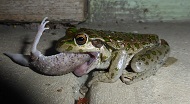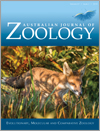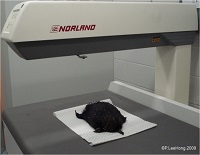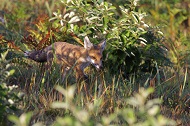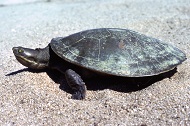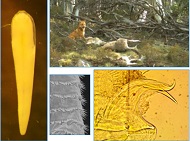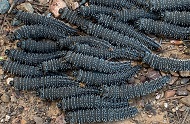Australian Journal of Zoology
Volume 67
Number 2 2019
The spotted-thighed frog (Litoria cyclorhyncha) is native to southern Western Australia, but has established an introduced population in South Australia. To determine the potential effects of the frog on other species and ecosystems, we analysed stomach contents of frogs in the introduced population and found it to be feeding indiscriminately on diverse fauna, potentially impacting on other species by predation and competition. Therefore, the spotted-thighed frog constitutes a potential threat to the native biodiversity of south-eastern Australia.
Photo by C. M. Taylor.
Little is known about the body composition of the echidna. This study validated, against chemical measurement, a non-invasive method, dual-energy X-ray absorptiometry (DXA), for the measurement of body composition of echidnas. The results show that DXA has potential to assess body composition of echidnas although further work is required to improve accuracy of measurement.
Photo by P. LeeHong.
The diet of the European red fox (Vulpes vulpes) was investigated through analysis of 1185 scats collected between 2010 and 2014 from coastal south-east Queensland, Australia. Fox diet was dominated by terrestrial arthropods, marine arthropods, vegetation and birds, although the remains of the short-tailed shearwater (Ardenna tenuirostris) consumed as carrion dominated the latter.
Photo by Julie O'Connor.
How behaviour affects a turtle’s body temperature has implications for its feeding, growth, reproduction and likely responses to climate change. I found that three Australian freshwater species differed in their tendency to regulate body temperature, both in nature and in the laboratory. The eastern long-necked turtle had the greatest such tendency, which may help to protect it from overheating and dehydration when on land.
Photo by Bruce C. Chessman.
Linguatula serrata is an introduced pentastomid parasite that infects a wide range of introduced and feral hosts. This paper provides the first verified report of L. serrata nymphs in a native Australian animal, the red-necked wallaby, from areas adjacent to Kosciuszko National Park. The need for more research on parasites of Australian wildlife is discussed.
Photos of whole parasite and hook: D. Barton; SEM: M. Porter; dog eating carcass: T. Rowley
Sawflies (or spitfires), Perga affinis affinis, feed on Eucalyptus trees with leaves that contain several secondary plant compounds. We measured feeding by sawflies in relation to one secondary compound and found that this compound did not affect feeding by these insects, but that they always preferred the leaves from the plant on which they hatched. Further work is needed on the sensory and digestive physiology of these insects to understand how they deal with secondary plant compounds.
Photo by Paul Cooper.
 , Gunnar Keppel, Shaun O'Sullivan, Stefan Peters, Gregory D. Kerr and Craig R. Williams
, Gunnar Keppel, Shaun O'Sullivan, Stefan Peters, Gregory D. Kerr and Craig R. Williams
